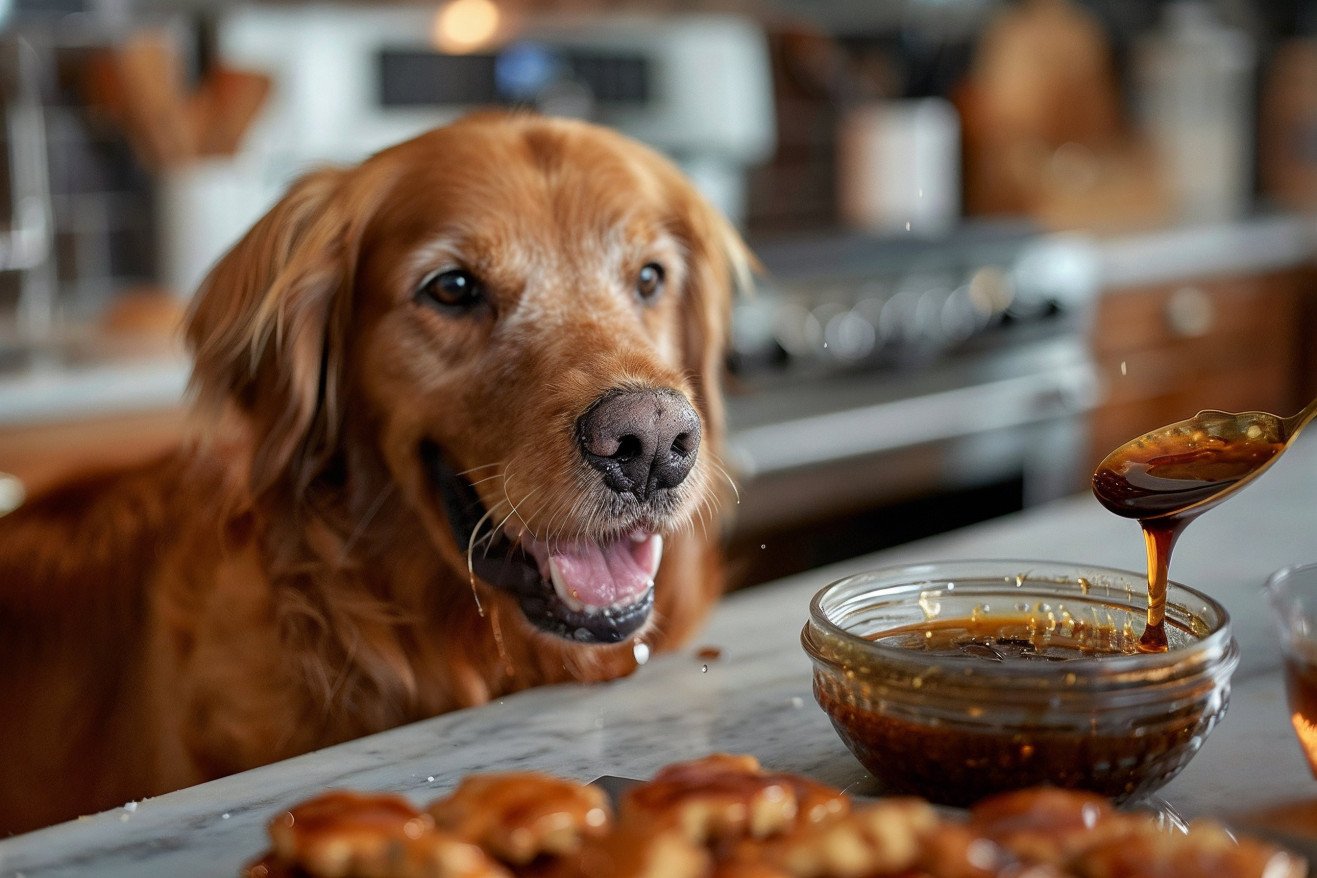Can Dogs Eat Molasses? A Healthy Way to Sweeten Your Pup’s Treats
18 March 2024 • Updated 18 March 2024

While we may use molasses to sweeten our baked goods, is it a good option for our furry friends? Dogs can eat molasses in small amounts, especially blackstrap molasses, which is lower in sugar and higher in vitamins and minerals.
However, it’s important to talk to your vet, as too much sugar can cause health problems in dogs. Also, make sure to avoid molasses that contains the artificial sweetener xylitol, which is toxic to dogs.
This article will take information from veterinary medicine, nutritional research, and research on dog nutrition to provide a comprehensive look at what happens when you add molasses to your dog’s diet. We’ll look at the benefits and risks, especially when it comes to blackstrap molasses and its potential uses. By looking at the research, we hope to give you a well-rounded view of how molasses can impact your dog’s health and well-being.
Can dogs eat molasses?
Nutritional Benefits of Blackstrap Molasses for Dogs
Blackstrap molasses is the result of the third boiling of sugarcane, which means the nutrients in the original plant are highly concentrated. WebMD notes that this type of molasses is especially high in minerals such as calcium, iron, magnesium, manganese, potassium, and vitamin B6. Even though it’s a type of sugar, blackstrap molasses has a lower sugar content and glycemic index than other sweeteners, which may help support a dog’s blood sugar levels.
The potential benefits of these minerals for dogs are many. Iron helps with blood health, calcium is important for bone health, and magnesium is involved in nerve and muscle function. Because blackstrap molasses is nutritionally different from other types of molasses, which are higher in sugar and lower in minerals, it’s the best type of molasses to give to dogs in moderation.
That said, Bulldogology Pet Solutions warns that it’s important to use blackstrap molasses in moderation because of its sugar content, which can lead to obesity and other health problems if it’s consumed in large amounts.
If you’re thinking about adding blackstrap molasses to your dog’s diet, it’s important to think of it as a way to add minerals to their diet instead of a way to add sugar, and to make sure you talk to your vet about it first.
Finding the Right Balance: How Sugar Fits Into Your Dog’s Diet
Dog owners should be mindful of the role of sugar in their dog’s diet. While sugar is not toxic to dogs, according to PetMD, consuming too much sugar can have serious consequences, including obesity, changes in metabolism, diabetes, and, in extreme cases, pancreatitis. Sugars from treats are refined and should be limited, while natural sugars from dog-safe fruits can be included in moderation.
MasterClass notes that dogs that consume too much sugar are at a higher risk of developing diabetes and heart disease. It’s important to note the difference between natural sugars, which come with additional nutrients and fiber, and refined sugars, which are empty calories that cause blood sugar levels to spike.
Dog owners should make sure that treats, even those that contain natural sugars, make up no more than 10% of their dog’s daily calorie intake, which should be made up mostly of high-quality dog food. As with any dietary change, moderation is key, and dog owners should watch their pets closely for any negative side effects when they introduce new treats like molasses.
Understanding Sweeteners: Molasses Metabolism in Man’s Best Friend
The metabolism of sweeteners, including molasses, in dogs is very different from that in humans. Dogs’ small intestines are set up to metabolize sugars and carbohydrates, and enzymes in the small intestine break down these molecules into monosaccharides that can be absorbed.
Volhard Dog Nutrition explains that blackstrap molasses, with its high nutrient content and lower sugar content, is the safest type of molasses for dogs, especially those with obesity and type 2 diabetes. That said, even blackstrap molasses should be given in small amounts to avoid potential blood sugar imbalances and gastrointestinal upset.
While it’s true that alternatives to refined sugar, like blackstrap molasses, offer more nutrients, it’s important to introduce these sweeteners to a dog’s diet with caution. Animal Wellness Magazine warns that overconsumption can have negative effects, including obesity and other health problems.
While there are no studies that have been specifically mentioned that look at how dogs metabolize molasses, experts, including Hepper, generally say that it’s important to use sweeteners in moderation and that the sugar content in sweeteners can lead to negative health impacts in dogs.
When thinking about adding molasses to a dog’s diet, it’s important to think about the dog’s overall nutrition. Every addition, including blackstrap molasses, should be part of a diet that meets all of a dog’s nutritional needs without leading to weight gain or metabolic issues.
Making It Work: How to Add Molasses to Your Dog’s Diet
If you’re thinking about adding blackstrap molasses to your dog’s diet, it’s important to do so in a way that minimizes the risk of digestive issues. Since it’s always best to introduce new foods gradually, PetMD recommends doing just that with molasses.
Start by mixing a small amount of molasses in with your dog’s regular food, and then slowly increase the amount over the course of a few days. This will help your dog’s digestive system get used to the new food.
It’s also important to make sure you’re feeding your dog an appropriate amount of molasses, as overfeeding can lead to health problems. Royal Canin recommends that you pay attention to your dog’s reaction to new foods. If you notice changes in your dog’s stool, gas, or vomiting, you may be feeding them too much molasses.
Hill’s Pet also recommends that you talk to your vet about the appropriate amount of calorie-dense foods like molasses to feed your dog. By getting your vet’s input and keeping an eye out for any changes in your dog’s health and well-being, you can make sure that this sweet treat is both safe and effective.
Glycemic Index in Dog Food: What Pet Owners Need to Know
The glycemic index (GI) plays an important role in managing a dog’s diet, especially when it comes to the use of sweeteners like molasses. The GI measures the effect of food on blood glucose levels, and it’s an important consideration for both people and dogs.
A study in the Journal of Animal Science developed a method to measure the GI in dogs and used it to evaluate the glycemic impact of different carbohydrate sources in dog food. This is important because it shows how foods like molasses may affect a dog’s blood sugar levels.
A study in PMC showed that diets containing different carbohydrate sources, including low-GI pulses, had an impact on the glycemic response and nutrient digestibility in dogs. Meanwhile, a study in PMC showed that diets can change the postprandial glycemic and insulin responses in healthy dogs, showing that the GI is an important consideration when choosing a dog’s diet.
Molasses, which has a lower GI than other sweeteners, may have a lower impact on blood sugar levels, which means it may be a better option when used in moderation. However, as with any dietary change, it’s important to monitor a dog’s response and consult a veterinarian to make sure the dog’s diet remains healthy and balanced.
Conclusion: Can Dogs Have Molasses?
In this article, we’ve looked at the potential benefits and drawbacks of giving your dog blackstrap molasses. While it can provide a variety of important nutrients, it’s important to remember that it should be used in moderation and with caution.
When given in small amounts and with the guidance of a veterinarian, blackstrap molasses can be a healthy addition to a dog’s diet due to its high mineral content and lower sugar content compared to other types of molasses.
We’ve also talked about the importance of sugar when it comes to a dog’s diet, and how natural sugars are better than refined sugars, but should still be limited. We’ve also talked about the metabolic concerns and the glycemic index’s application to dogs, and how it’s important to carefully consider any dietary changes to make sure they’re in the best interest of your pet.
In short, part of being a responsible pet owner is understanding the impact of the foods you give your pet, including molasses. This includes talking to a veterinarian and following their advice. In addition, anyone who is considering giving their dog molasses should make sure to do additional research or talk to a professional to make sure that it will be a healthy addition to their pet’s diet.


